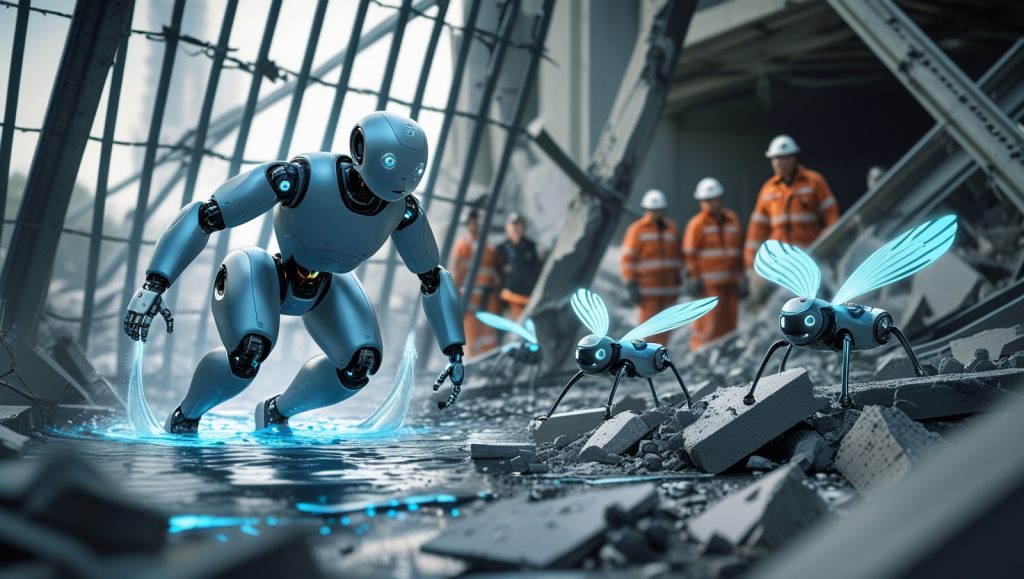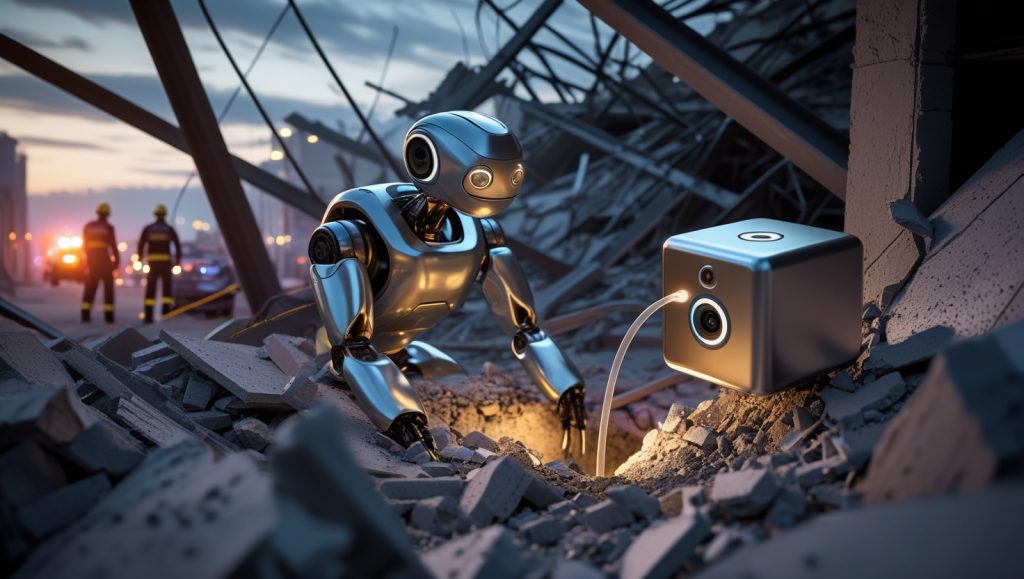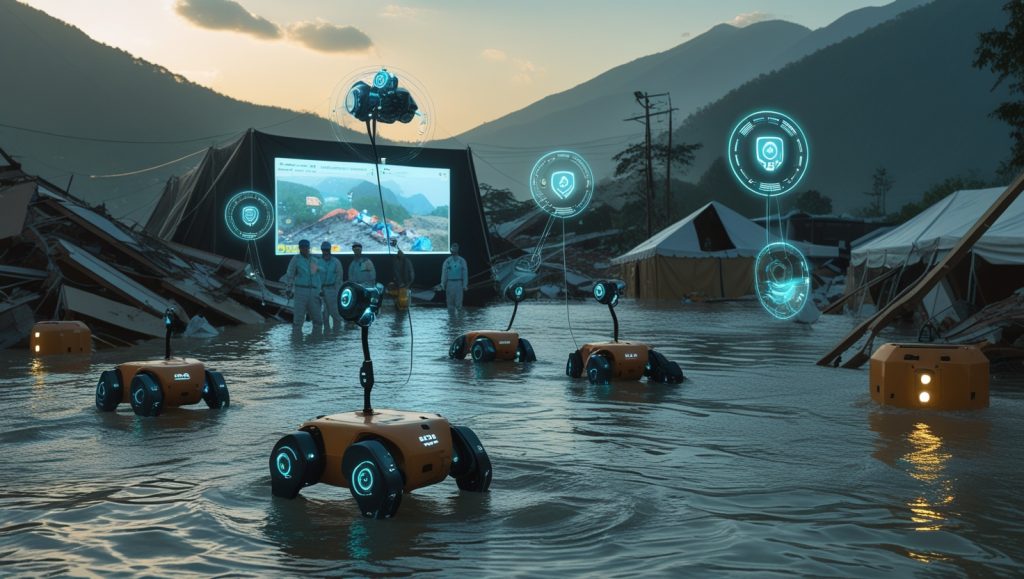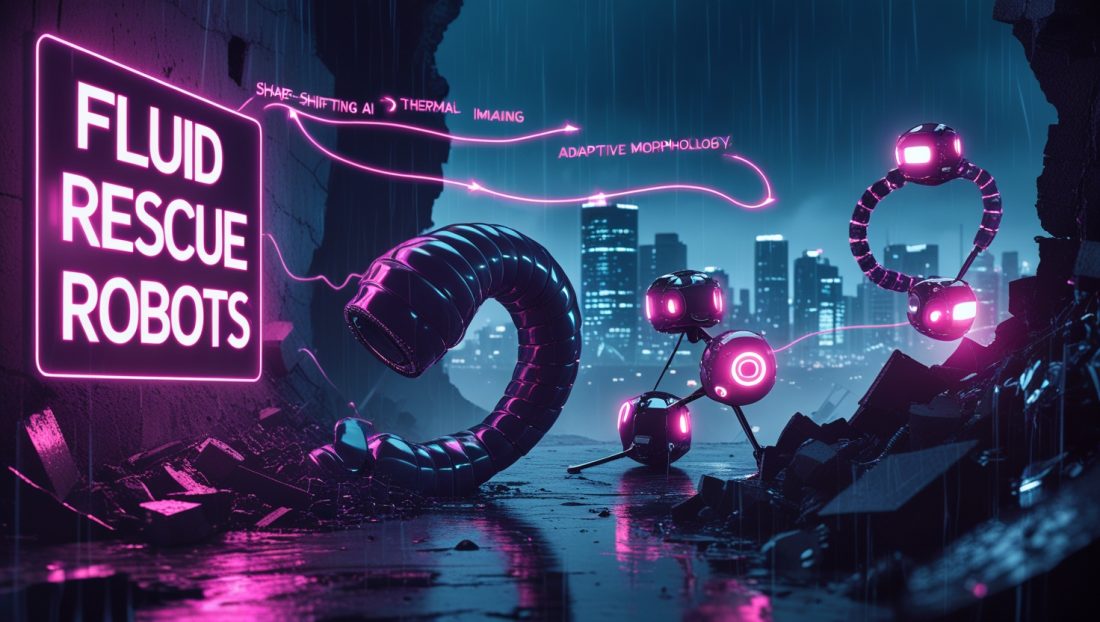Imagine a robot that melts into cracks like the T-1000 in Terminator 2, slipping through rubble to find survivors trapped in a collapsed building. In 2025, fluid rescue robots are bringing this sci-fi vision to life, transforming how we tackle search-and-rescue missions in disaster zones. Inspired by the adaptability of fluid dynamics, these machines morph their shape to navigate tight, unpredictable spaces where rigid robots and human responders falter. From earthquakes to industrial accidents, the ability of fluid rescue robots to flow like liquid and reform with purpose is reshaping disaster response. This article explores their cutting-edge technology, real-world impact, and why they’re a lifeline in crises.
What Are Fluid Rescue Robots?

Fluid rescue robots are a new breed of machines designed to adapt their form dynamically, much like water flowing through a maze. Unlike traditional robots with fixed structures, these bots use flexible materials or modular systems to change shape, allowing them to squeeze through narrow gaps, climb over debris, or envelop objects for stability. Drawing on fluid dynamics—the science of how liquids and gases move—these robots mimic the adaptability of a liquid, reforming like the T-1000 emerging from a molten puddle.
Researchers at Seoul National University in South Korea have developed a prototype that embodies this concept. Their robot, made of magnetoactive soft materials, can shift from a solid to a liquid-like state to pass through metal grids, then reform to carry out tasks. “Our shape-shifting robot transitions from solid to fluid states, enabling navigation through complex environments,” the team reported in Science Blog source. This technology builds on earlier work, like the 2023 “magnetic slime” robot, which could slip through spaces as narrow as 1.5 mm.
Across the globe, Chinese engineers at Tsinghua University are advancing similar concepts. Their microrobot, one of the smallest shapeshifters yet, uses a morphable actuator to switch between crawling and flying modes. “This design allows unparalleled flexibility for rescue operations,” noted lead researcher Dr. Zhang Wei in a 2025 SCMP article source. These innovations highlight how fluid rescue robots are pushing the boundaries of robotics in disaster scenarios.
Why Fluid Rescue Robots Are Critical for Disaster Response
Disasters like earthquakes or building collapses create chaotic environments—jagged rubble, tight crevices, and unstable structures. Human responders risk their lives navigating these spaces, while traditional robots often get stuck or lack the flexibility to adapt. Fluid rescue robots address these challenges by flowing through obstacles like liquid, then reforming to perform tasks like deploying sensors or cameras.
Take the 2010 Haiti earthquake, where over 200,000 lives were lost, and rescue teams struggled to reach victims trapped in collapsed structures. A fluid rescue robot could have melted into cracks, delivering real-time data on survivor locations. In 2025, these robots are being tested in simulated disaster zones, with prototypes carrying thermal imaging to detect body heat or microphones to pick up faint cries for help. Their ability to adapt on the fly makes them indispensable.
For a broader look at robotics in high-stakes environments, explore how untethered deep-sea robots are revolutionizing ocean exploration, tackling similar challenges of navigating unpredictable spaces.
A Fictional Anecdote: The Robot That Flowed to Save

Note: The following story is fictional for illustrative purposes.
Picture a city hit by a sudden explosion, leaving a warehouse in ruins. Among the debris is Jamal, a worker trapped in a pocket beneath twisted steel. The rescue team deploys a fluid rescue robot, a sleek device that melts into a liquid-like state, oozing through a 2-inch gap like the T-1000 sliding under a door. Once inside, it reforms into a compact cube, equipped with a camera and oxygen tube. The robot locates Jamal, streams his vitals to the team, and delivers a small oxygen supply, buying critical time. Within hours, rescuers clear a path to free him, guided by the robot’s precise data. Jamal emerges shaken but alive, a testament to the robot’s fluid ingenuity.
This fictional scenario mirrors the real potential of fluid rescue robots to save lives where traditional methods fall short. Like the T-1000 reforming after a blast, these robots adapt to any challenge, offering hope in the darkest moments.
How Fluid Dynamics Powers These Robots
The secret behind fluid rescue robots lies in fluid dynamics, the study of how fluids adapt to their environment. Engineers use materials like magnetoactive polymers or liquid-metal composites that can transition between states. For instance, South Korea’s prototype uses magnetic fields to control its phase, allowing it to flow like mercury through tight spaces before solidifying to carry out tasks. “It’s like watching the T-1000 come to life, but for saving people,” an X post enthused, capturing the public’s fascination.
Another approach involves modular designs, where robots consist of tiny units that move like a school of fish, reconfiguring as needed. Japan’s RIKEN Institute is exploring such systems, with robots that split and recombine to navigate rubble. These designs draw on fluid dynamics’ principles of adaptability, ensuring robots can handle the unpredictable nature of collapsed structures.
To see how modular robotics is evolving, check out why self-healing robotics might be the next frontier, offering insights into adaptive technologies.
Why Fluid Rescue Robots Outshine Traditional Methods
The strength of fluid rescue robots lies in their versatility. Unlike robotic dogs, which excel in open terrain (as explored in 2025 robot dog navigation rescue), fluid robots thrive in confined spaces. They can:
- Squeeze through gaps as small as a few millimeters.
- Carry sensors to detect survivors’ heat signatures or sounds.
- Deliver supplies like water or oxygen in tight spaces.
- Operate autonomously, reducing human risk.
In the 2019 Notre-Dame fire, rigid drones struggled to navigate the cathedral’s damaged interior. A fluid rescue robot could have flowed through charred beams, assessing structural integrity without endangering responders. However, these robots aren’t perfect. Their reliance on advanced materials like liquid-metal composites makes them costly, and battery life remains a limitation for extended missions. “We’re working on energy-efficient designs to extend operational time,” says Dr. Kim Soo-Hyun from Seoul National University.
The Future of Fluid Rescue Robots

By 2030, fluid rescue robots could be standard in disaster response kits. Advances in AI, like those powering Microsoft’s Magma AI, are enabling these robots to make autonomous decisions, prioritizing tasks based on real-time data. For example, NVIDIA’s Isaac Sim platform is training robots to navigate simulated disaster zones, enhancing their ability to adapt like liquid in unpredictable settings.
Yet, ethical concerns persist. Could overreliance on these robots reduce human involvement in rescues? And what if a robot fails mid-mission, leaving survivors stranded? These questions demand rigorous testing and clear protocols. As Dr. Zhang Wei notes, “The technology is promising, but trust must be earned through reliability.”
Why Cost and Accessibility Remain Hurdles
The high cost of fluid rescue robots is a major barrier. Prototypes using magnetoactive materials or modular actuators can cost $50,000 or more, limiting their use in low-resource regions. Scaling production to lower costs is a priority, as is training responders to operate these complex systems. Initiatives like STEM robotics competitions could inspire the next generation to tackle these challenges, making fluid robots more accessible.
FAQ: Fluid Rescue Robots
How do fluid rescue robots work in collapsed structures?
They use flexible materials or modular designs to change shape, flowing through tight spaces and reforming to perform tasks like sensing or delivering supplies.
Are fluid rescue robots affordable for widespread use?
Not yet—prototypes are expensive, but mass production could reduce costs by 2030, making them viable for global disaster response.
Can these robots replace human rescuers?
No, they complement human efforts by accessing dangerous areas, but human judgment remains essential for complex decision-making.
What makes fluid rescue robots different from other rescue robots?
Their ability to mimic fluid dynamics allows unmatched adaptability, unlike rigid robots or even advanced robotic dogs.
A Liquid Lifeline for Disaster Response
Fluid rescue robots, flowing like the T-1000 through rubble, are redefining search-and-rescue in 2025. Their ability to adapt to collapsed structures offers hope where traditional methods fall short. While costs and technical challenges remain, the progress is undeniable, from South Korea’s liquid-metal bots to Japan’s modular designs. These machines aren’t just tools—they’re the future of saving lives.
Stay ahead of robotics breakthroughs by subscribing to our newsletter and exploring how robotics is fighting climate change. Let’s shape a safer tomorrow together.



